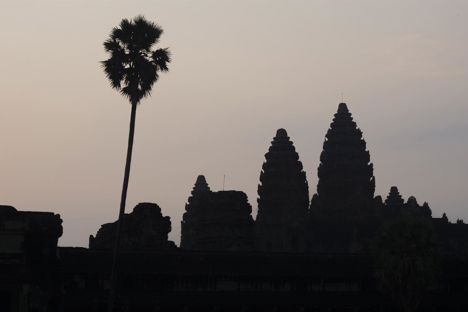
A Cambodian royal Khmer cooking class
Cambodian cuisine is full of rich history and traditions, which Leyla discovered when she took part in a Royal Khmer cooking class. Here she describes her eye-opening experience and some of the delicious food cooked on the day.
A Cambodian royal Khmer cooking class
Cambodian cuisine is full of rich history and traditions, which Leyla discovered when she took part in a Royal Khmer cooking class. Here she describes her eye-opening experience and some of the delicious food cooked on the day.
History is a big part of Cambodia's identity. From the vast ancient site of Angkor, the capital of an empire that once controlled most of Southeast Asia, twice the size of Manhattan, and hidden from the world behind thick jungle until missionaries discovered it in 1860; to the horrors and atrocities Pol Pot inflicted on his own people during the brutal four year Khmer Rouge regime, as recent as the 1970's; and, everything in between.
Cambodia's past can very much be felt today. I came across people, my parents’ age, with missing limbs – a reminder of the country's recent conflicts and the land mines used in them. Old, gnarly trees grow stubbornly sideways, breaking through pavements, making the place feel like it's been there forever.
But the thing that struck me the most were the people. Always warm and smiling, pleased you want to visit their country, proud of their identity – however scarred that may be – and willing to share all that they have, even if that’s not much.
Part of the culture Cambodians are so keen for the rest of the world to experience is the cuisine. Often seen as the dowdy sibling to those from its neighbouring Southeast Asian countries, I don't think many people know much, if anything, about Khmer / Cambodian cuisine; I certainly didn't. And what better way to get a firm grasp of the basics than by listening to someone who knows what they're talking about, and having a go yourself.
I took part in a truly fantastic Royal Khmer Cooking Class at Raffles Grand Hotel d'Angkor in Siem Reap. Even though it was my own fair hands that rustled up each of the five courses (under the guidance and supervision of Chef Ming Tin), they were all entirely excellent. I'm under no illusion – that was mostly thanks to the teacher and produce, rather than the student.
The class began at 10am with a couple of the hotel’s chefs driving us to, and guiding us around, the local wet market, to provide a glimpse into the daily lives of Cambodians and the comestible wares they trade. Don't worry, the hotel doesn't purchase its ingredients from here. Probably a good thing; there were a lot of flies. The most I’ve ever seen in any market.
Incidentally, the markets of Cambodia were some of the most aromatic I came across during my travels around Asia. Garlic, ginger, galangal, lemongrass, turmeric, chillies, great piles of just-made curry pastes, all mingling and cooking in the unrelenting sun. It makes you damn hungry.
The remaining two to three hours of the class, back at the hotel, involved Chef Ming Tin talking through the history of Cambodian and Khmer cuisine, demonstrating five typical Khmer dishes, and then overseeing our own creations. We got to eat all the wonderful stuff we made, and attendees are given a little Khmer recipe book to take away with them.
Traditional Khmer cuisine is one of detail, I learnt; of small amounts of ingredients with complimentary textures, complex aromas and exhilarating flavours. Rice is a sacred component; fish and shellfish are gathered from the Mekong and Tonlé Sap rivers; garlic is very prevalent; and Buddhist guidelines dictate cooking methods.
Here are the dishes we rustled up, and the ingredients that went in them:
Green mango and prawn salad
Sour fish soup with pineapple
A broth of chicken stock, fish sauce and sour tamarind juice with seafood, galangal, tomato and pineapple, served with sliced chillies, ma om leaves and fried chopped garlic.
Also known as rice paddy herb, ma om (ម្អម) is an aromatic herb traditionally used in Cambodian soups, due to its lemony, citrus aroma and flavour. Ma om is native to Southeast Asia and grows in drained rice paddies, after the rice has been harvested. It is then picked and dried on the roof of houses all over rural Cambodia.
Red chicken curry - kari sach moan
Here, chicken is cooked in a stock with onion, potato, coconut milk, fish sauce, sugar, salt, peanuts, and a cracking curry paste made from galangal, turmeric, kaffir lime, lemongrass, garlic, shallots, chilli and shrimp paste. More yellow than red, but glorious nonetheless.
Wok-fried black peppered beef - sach ko loc lak
The marinade sees beef sitting in a slick of oyster sauce, loads of black pepper, garlic, sugar and soy. It’s then cooked with Chinese wine, more garlic and dark soy, and served with a punchy dipping sauce of lime and black pepper. Dark, sticky, succulent, so much flavour. This was incredible.
Pumpkin custard - sang khya l'peouv
This pumpkin custard was so very excellent, and so easy. A very popular Cambodian dessert, and also found in Thailand.
Royal Khmer Cooking Classes at Raffles Grand Hotel d'Angkor, Siem Reap are $85 USD per person.
All images © Leyla Kazim 2015.

